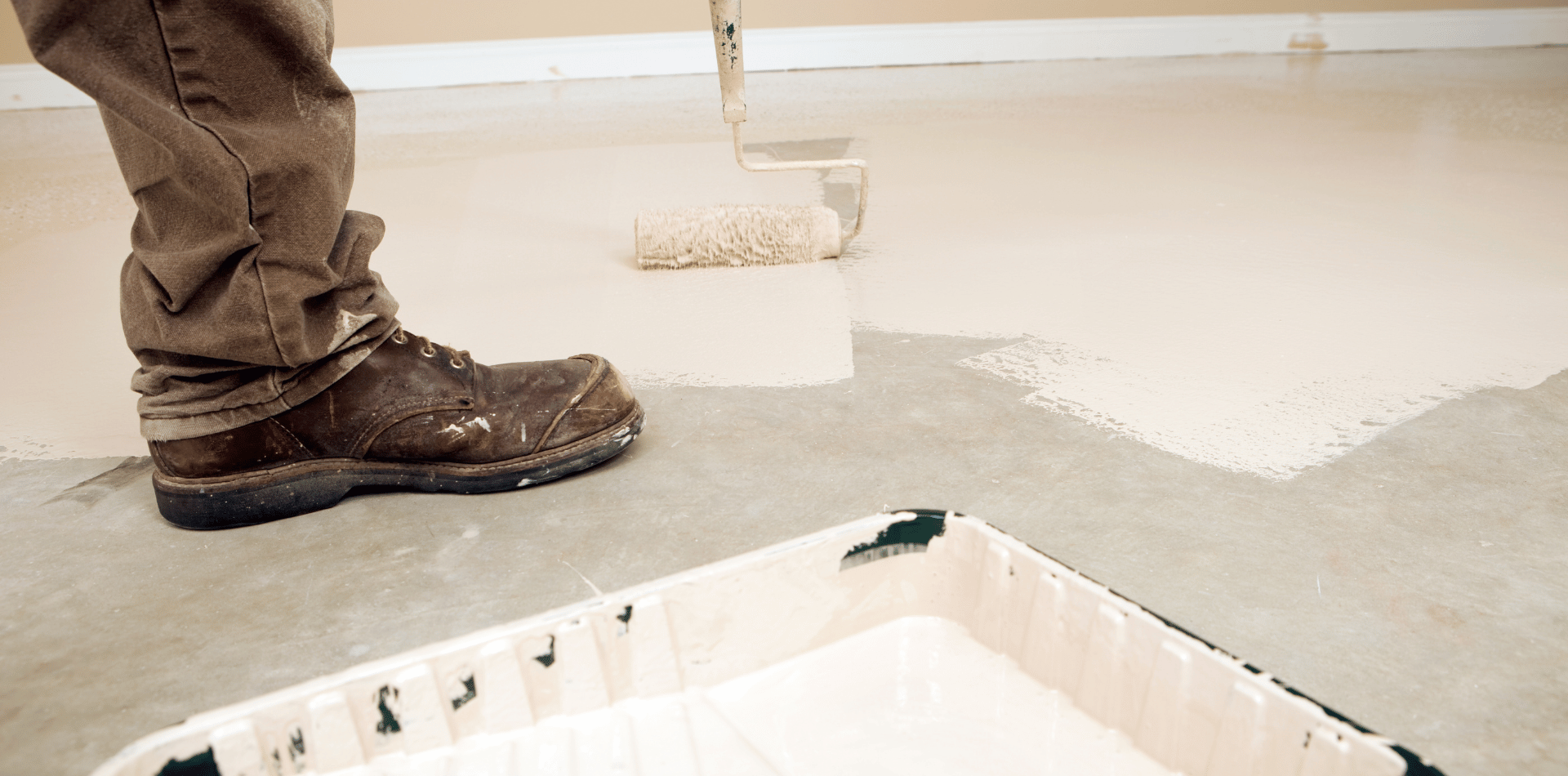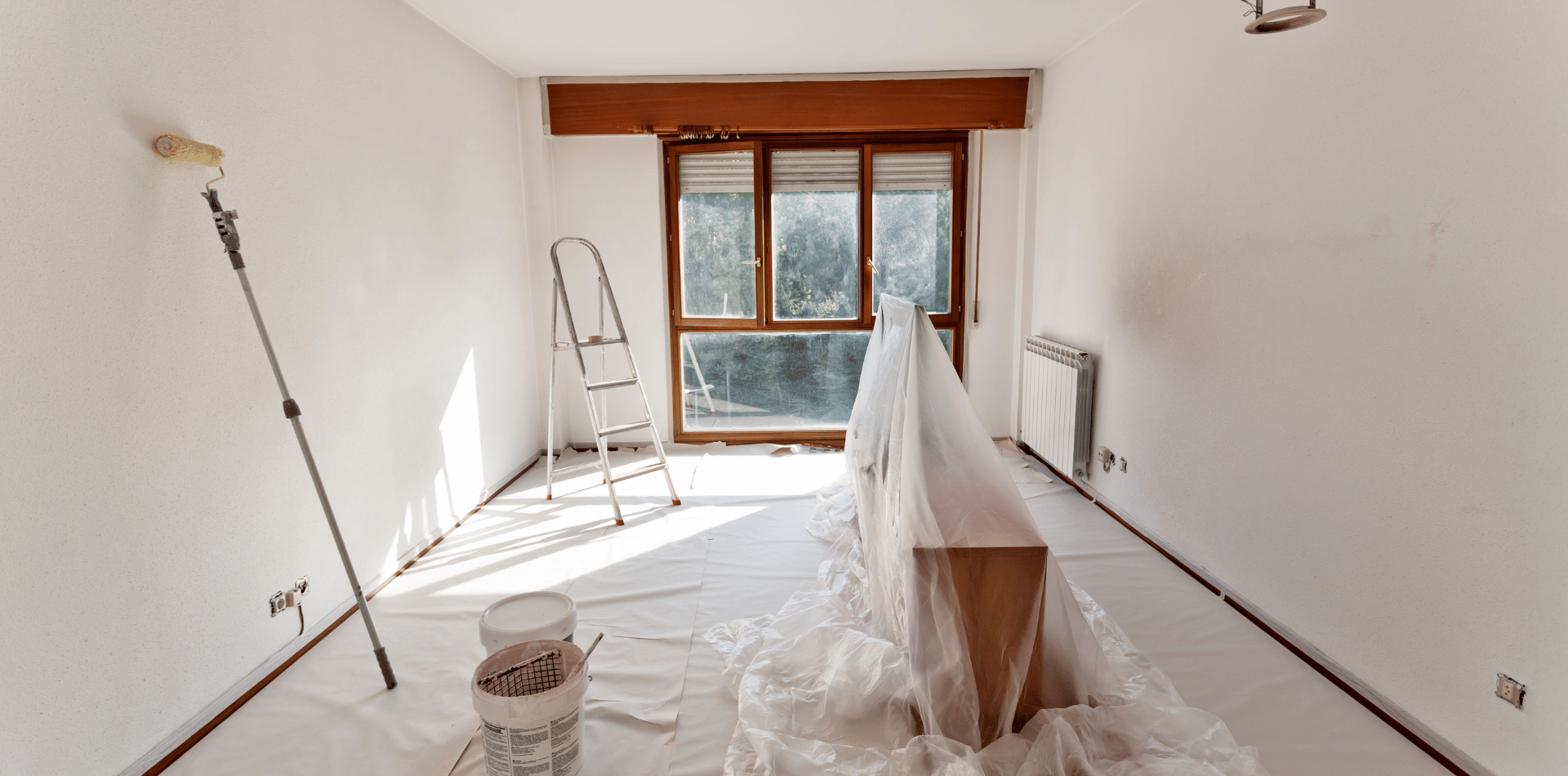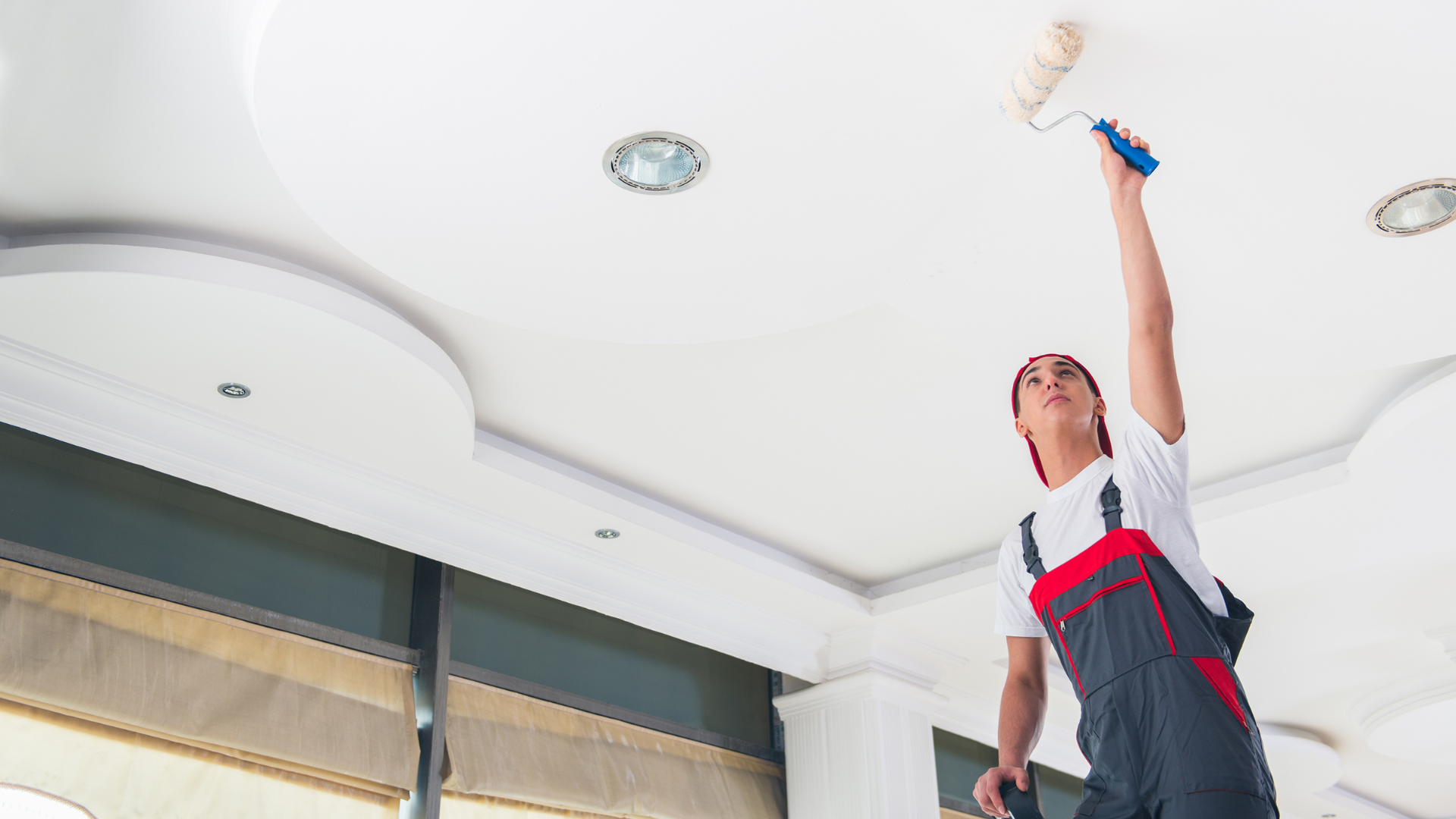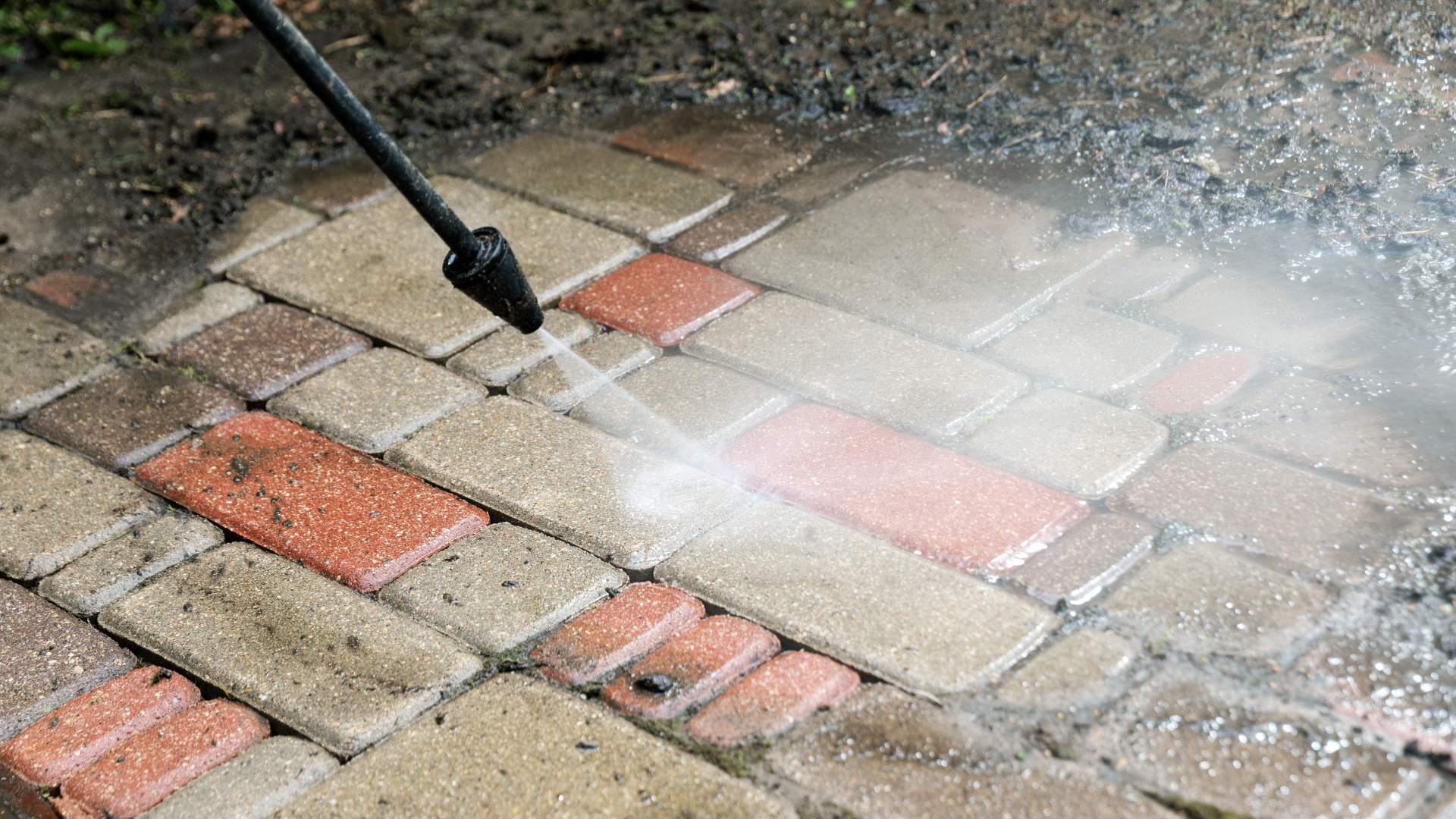Why Concrete Paint Differs from House Paint

Composition: The Core Difference Between Concrete Paint and House Paint
The fundamental distinction between concrete paint and house paint lies in their composition.
While both types of paint aim to enhance aesthetics and protect surfaces, their formulations are tailored to meet the specific demands of different substrates.
House paint is typically designed for smooth, less porous surfaces, whereas concrete paint is engineered to handle the unique characteristics of rough, porous concrete.
Let's look into the composition of each type of paint and highlights the ingredients that make concrete paint particularly suited for its intended applications.
Composition of House Paint
House paint, also known as interior or exterior paint, is formulated to provide a smooth, durable finish on surfaces like Gyprock, wood, plaster, and previously painted surfaces. Its composition generally includes the following components:
Pigments:
- Colourants: Pigments provide the colour and opacity of the paint. They are finely ground particles that remain suspended in the paint.
- Extenders: These are added to improve the paint's texture, reduce gloss, and enhance coverage. Common extenders include calcium carbonate and clay.
Binders:
- Acrylic Resins: Acrylic binders are widely used in house paint due to their excellent adhesion, flexibility, and resistance to UV light and weathering.
- Vinyl Acrylic: Often used in interior paints, vinyl acrylic binders offer good adhesion and are cost-effective.
- Alkyd (Oil-Based) Resins: Alkyd binders provide a durable, glossy finish and are commonly used in exterior and trim paints.
Solvents:
- Water (Water-Based Paints): Water-based or latex paints use water as the primary solvent, making them easy to clean up and environmentally friendly.
- Organic Solvents (Oil-Based Paints): Oil-based paints use organic solvents like mineral spirits or turpentine, providing a durable, high-gloss finish but requiring more ventilation and cleanup.
Additives:
- Thickeners: Thickeners control the viscosity of the paint, ensuring a smooth application and preventing drips and sagging.
- Preservatives: These protect the paint from microbial growth and extend its shelf life.
- Surfactants: Surfactants help the pigments and binders mix uniformly and improve the paint's wetting properties.
Composition of Concrete Paint
Concrete paint is specifically formulated to address the challenges posed by concrete surfaces. Its composition includes ingredients that enhance adhesion, durability, flexibility, and resistance to environmental factors.
Key components of concrete paint are:
Pigments:
- Colourants: Similar to house paint, pigments in concrete paint provide colour and opacity. However, they are often chosen for their resistance to fading and chalking under harsh conditions.
- Reflective Pigments: Some concrete paints include reflective pigments to reduce heat absorption, which can be beneficial for surfaces exposed to direct sunlight.
Binders:
- Acrylic Polymers: High-quality acrylic binders provide excellent adhesion to rough, porous concrete surfaces. They also offer flexibility and UV resistance, making them suitable for outdoor use.
- Epoxy Resins: Epoxy binders are known for their exceptional durability, chemical resistance, and adhesion. They are often used in industrial and commercial settings where the surface must withstand heavy wear and exposure to chemicals.
Solvents:
- Water (Water-Based Concrete Paints): Water-based concrete paints are easier to apply, have low VOC (volatile organic compounds) content, and are environmentally friendly.
- Solvent-Based Paints: These paints use organic solvents to provide a harder, more durable finish. They are ideal for areas that require a tough, long-lasting coating.
Additives:
- Adhesion Promoters: These additives enhance the paint's ability to bond with the rough, porous surface of concrete, ensuring a long-lasting finish.
- Flexible Polymers: Flexible polymers allow the paint to expand and contract with the concrete, preventing cracks and maintaining a smooth finish.
- Hydrophobic Agents: These agents repel water, enhancing the paint's ability to prevent moisture ingress and protect the concrete substrate.
- UV Stabilizers: UV stabilizers protect the paint from degradation due to sunlight exposure, preventing fading and chalking.
- Anti-Slip Additives: For surfaces like driveways, patios, and walkways, anti-slip additives improve traction and safety.
Key Differences in Composition and Performance
Adhesion:
- House Paint: Designed for smoother surfaces, house paint relies on a more straightforward adhesion process, primarily bonding through surface contact.
- Concrete Paint: Formulated with adhesion promoters and binders that penetrate the porous concrete, concrete paint ensures a strong, lasting bond that prevents peeling and flaking.
Durability:
- House Paint: Provides sufficient durability for interior and exterior applications but may not withstand the extreme conditions often faced by concrete surfaces.
- Concrete Paint: Includes robust binders like epoxy and specialised additives that offer superior resistance to abrasion, chemicals, and environmental factors.
Flexibility:
- House Paint: While flexible enough for typical household surfaces, house paint may crack or peel when applied to substrates that undergo significant expansion and contraction.
- Concrete Paint: Contains flexible polymers that accommodate the movement of concrete due to temperature changes, preventing cracks and maintaining a smooth, durable finish.
Protection:
- House Paint: Protects against standard environmental factors such as UV rays and moisture but is not designed for heavy-duty protection.
- Concrete Paint: Offers enhanced protection against water ingress, freeze-thaw cycles, chemical spills, and UV exposure, making it ideal for both residential and industrial concrete surfaces.
Practical Implications of Composition Differences
Application Environments:
- House Paint: Best suited for interior walls, trim, and exterior siding where surfaces are relatively smooth and stable.
- Concrete Paint: Ideal for driveways, patios, garage floors, basements, industrial floors, and exterior walls where surfaces are rough, porous, and exposed to harsh conditions.
Maintenance and Longevity:
- House Paint: Requires regular maintenance and touch-ups to keep surfaces looking fresh, especially in high-traffic areas.
- Concrete Paint: Offers long-lasting protection with minimal maintenance, reducing the need for frequent recoating and repairs.
The composition of concrete paint is carefully engineered to meet the unique demands of concrete surfaces. By incorporating specialised binders, flexible polymers, and various protective additives, concrete paint ensures superior adhesion, durability, flexibility, and protection compared to traditional house paint. Whether for residential, commercial, or industrial applications, understanding these compositional differences is crucial for selecting the right paint and achieving optimal results.
Application Methods: The Crucial Steps for Effective Concrete Paint and House Paint Application
Applying paint to any surface involves a series of steps to ensure a smooth, durable, and aesthetically pleasing finish. However, the application process for concrete paint is typically more involved than that for house paint. This is primarily due to the nature of concrete as a rough, porous material that requires thorough preparation to ensure proper adhesion and longevity of the paint. In contrast, house paint is generally applied to smoother surfaces that need less intensive preparation.
Here's a detailed look at the application methods for both types of paint and understand why concrete paint demands more meticulous preparation.
Application Methods for Concrete Paint
Surface Preparation:
- Cleaning:
- Dirt and Debris Removal: Concrete surfaces must be free of dirt, dust, grease, and other contaminants. This can be achieved using a pressure washer or a stiff-bristle brush with a concrete cleaner.
- Oil and Grease Stains: These stains need to be removed using a degreaser, as oil and grease can prevent paint from adhering properly.
- Etching:
- Acid Etching: This process involves applying a diluted acid solution (usually muriatic acid) to the concrete surface. Acid etching opens up the pores of the concrete, creating a rougher texture that enhances paint adhesion. After etching, the surface must be thoroughly rinsed and allowed to dry completely.
- Mechanical Etching: Alternatives to acid etching include mechanical methods like grinding or shot blasting, which physically roughen the surface to improve adhesion.
- Priming:
- Concrete Primer: Applying a concrete primer is crucial for sealing the porous surface and providing a uniform base for the paint. Primers also enhance the bond between the concrete and the paint, ensuring a longer-lasting finish.
Painting:
- Choosing the Right Tools:
- Rollers and Brushes: Use high-quality rollers and brushes designed for rough surfaces. Rollers with a thick nap are ideal for applying paint to the uneven texture of concrete.
- Sprayers: For large areas, a paint sprayer can be used for a more uniform and efficient application.
- Applying the Paint:
- First Coat: Apply the first coat of concrete paint evenly, ensuring that all pores and cracks are filled. Allow sufficient drying time as recommended by the manufacturer.
- Second Coat: Apply a second coat to achieve the desired thickness and coverage. This coat ensures that the paint is robust enough to withstand environmental and mechanical stresses.
- Curing Time:
- Drying and Curing: Allow the paint to cure completely before subjecting it to foot traffic or placing heavy objects on it. Curing times can vary depending on the paint type and environmental conditions.
Application Methods for House Paint
Surface Preparation:
- Cleaning:
- Dust and Dirt Removal: Clean the surface with a mild detergent solution to remove dust, dirt, and grease. For exterior surfaces, a garden hose or pressure washer can be used.
- Mildew Treatment: If mildew is present, treat the area with a mildew remover and rinse thoroughly.
- Sanding:
- Smoothing the Surface: Sanding is necessary to smooth out rough areas, remove loose paint, and create a slightly abrasive surface for better paint adhesion.
- Dust Removal: After sanding, clean the surface to remove all dust and debris.
- Priming:
- Surface-Specific Primers: Depending on the material (wood, drywall, previously painted surfaces), select the appropriate primer. Primers enhance adhesion, block stains, and provide a uniform base for the topcoat.
Painting:
- Choosing the Right Tools:
- Rollers and Brushes: Use quality rollers and brushes suitable for the type of paint and the surface being painted. Rollers with a medium nap are typically used for walls, while brushes are used for edges and trim.
- Sprayers: For large, flat surfaces, a paint sprayer can provide a smooth, even coat.
- Applying the Paint:
- First Coat: Apply the first coat evenly, using smooth, consistent strokes. Allow adequate drying time as recommended by the paint manufacturer.
- Second Coat: Apply a second coat to ensure complete coverage and a uniform finish.
- Touch-Ups:
- Final Inspection: After the paint has dried, inspect the surface for any missed spots or uneven areas. Touch up as necessary to achieve a flawless finish.
Comparing the Application Processes
Preparation Intensity:
- Concrete Paint: The preparation for concrete surfaces is more intensive due to the need for thorough cleaning, etching, and priming. These steps are critical for ensuring proper adhesion and durability.
- House Paint: Preparation for house paint involves cleaning, sanding, and priming but is generally less rigorous than the preparation required for concrete paint.
Surface Characteristics:
- Concrete: The rough, porous nature of concrete demands specialized preparation techniques like acid etching or mechanical etching to enhance adhesion.
- House Surfaces: House surfaces, such as drywall, wood, or plaster, are smoother and require less aggressive preparation methods.
Tools and Techniques:
- Concrete Paint: Applying concrete paint often requires tools designed for rough surfaces, such as thick-nap rollers and industrial-grade sprayers.
- House Paint: Applying house paint can be done with standard rollers, brushes, and consumer-grade sprayers.
Environmental Considerations:
- Concrete Paint: Environmental factors like temperature and humidity play a significant role in the application and curing of concrete paint. It's essential to follow manufacturer recommendations to ensure optimal results.
- House Paint: While environmental factors also affect house paint, the impact is typically less critical compared to concrete paint applications.
The application methods for concrete paint and house paint differ significantly due to the unique characteristics of the surfaces they are designed for. Concrete paint requires a more involved preparation process, including cleaning, etching, and priming, to ensure proper adhesion and durability on rough, porous surfaces.
In contrast, house paint is generally applied to smoother surfaces with less intensive preparation. Understanding these differences is crucial for achieving the best results and ensuring the longevity and performance of the painted surfaces. Whether working on a concrete driveway or an interior wall, following the appropriate application methods is key to a successful painting project.

Performance Requirements: House Paint vs. Concrete Paint
When selecting paint for a project, understanding the performance requirements is crucial to achieving the desired results and ensuring longevity.
House paint and concrete paint serve different purposes and are formulated to meet distinct performance criteria.
While house paint is primarily designed to enhance aesthetics and offer basic protection, concrete paint is engineered to endure harsher conditions and provide a robust protective layer for concrete surfaces.
Here are the specific performance requirements for each type of paint and understand how they cater to their respective applications.
Performance Requirements for House Paint
House paint is primarily focused on providing an attractive finish while offering a degree of protection suitable for interior and exterior surfaces like wood and plaster.
Here are the key performance requirements for house paint:
Aesthetic Appeal:
- Colour and Finish: House paint is available in a wide range of colours and finishes (matte, satin, semi-gloss, and gloss) to suit various design preferences and interior decor styles.
- Consistency: It should provide a smooth, even application with consistent colour and sheen across the entire surface.
Basic Protection:
- Moisture Resistance: While not designed for extreme moisture protection, house paint should resist occasional splashes and humidity, especially in kitchens and bathrooms.
- Mild Abrasion Resistance: It should withstand everyday wear and tear, such as minor scuffs and cleaning.
Ease of Application:
- User-Friendly: House paint should be easy to apply with minimal preparation. It should flow smoothly off brushes and rollers and have a reasonable drying time.
- Low Odour and Low VOC: Modern house paints often have low levels of volatile organic compounds (VOCs) to reduce odor and improve indoor air quality.
Durability:
- UV Resistance: For exterior applications, house paint should resist fading and degradation due to sunlight exposure.
- Stain Resistance: It should be easy to clean and resist stains from everyday household activities.
Performance Requirements for Concrete Paint
Concrete paint, while also providing aesthetic benefits, is engineered to meet stringent performance requirements to protect and enhance concrete surfaces. These surfaces are often exposed to harsher environmental and physical conditions, necessitating robust performance attributes:
Enhanced Durability:
- Abrasion Resistance: Concrete paint must withstand heavy foot and vehicle traffic, as well as mechanical impacts from equipment and machinery. This is crucial in areas like driveways, garages, and industrial floors.
- Chemical Resistance: It should resist damage from chemicals, oils, solvents, and other substances that concrete surfaces are frequently exposed to, especially in industrial and commercial settings.
Environmental Protection:
- Waterproofing: Concrete paint should form a waterproof barrier that prevents water ingress, protecting the concrete from moisture-related issues such as efflorescence, mold, and mildew.
- Freeze-Thaw Resistance: In cold climates, it should withstand the expansion and contraction caused by freeze-thaw cycles, preventing cracks and spalling.
- UV Protection: Outdoor concrete surfaces require paint that can resist UV rays, preventing fading, chalking, and deterioration due to prolonged sun exposure.
Adhesion and Flexibility:
- Strong Adhesion: Concrete paint must adhere effectively to the rough, porous surface of concrete, ensuring a long-lasting bond that prevents peeling and flaking.
- Flexibility: It should accommodate the natural expansion and contraction of concrete due to temperature changes, preventing cracks in the paint film.
Safety and Functionality:
- Anti-Slip Properties: For surfaces like driveways, patios, and walkways, concrete paint should include anti-slip additives to improve traction and safety.
- Breathability: It should allow moisture vapour to escape from within the concrete while preventing liquid water from penetrating the surface, ensuring the concrete remains dry and structurally sound.
Chemical and Stain Resistance:
- Ease of Cleaning: Concrete paint should provide a non-porous, easy-to-clean surface that resists stains from oils, chemicals, and other contaminants commonly found in industrial and commercial environments.
Application Requirements:
- Surface Preparation: The preparation process for concrete paint involves cleaning, etching, and priming to ensure optimal adhesion and performance.
- Multiple Coats: Often, multiple coats of concrete paint are necessary to achieve the desired thickness and durability, requiring careful application and curing.
Comparing Performance Requirements
Aesthetic vs. Protective Focus:
- House Paint: Primarily designed to enhance the appearance of interior and exterior walls with a focus on providing colour, finish, and basic protection.
- Concrete Paint: Focused on delivering superior protection and durability for concrete surfaces, while also providing aesthetic improvements.
Environmental Resistance:
- House Paint: Offers basic resistance to moisture, UV rays, and mild abrasion, suitable for residential applications.
- Concrete Paint: Provides robust resistance to harsh environmental factors, including water, chemicals, abrasion, and UV exposure, necessary for both residential and industrial settings.
Surface Adaptation:
- House Paint: Formulated for smoother, less porous surfaces like drywall, wood, and plaster.
- Concrete Paint: Engineered to adhere to rough, porous concrete surfaces and to accommodate their natural movements.
Longevity and Maintenance:
- House Paint: Requires periodic maintenance and touch-ups to maintain appearance and protection.
- Concrete Paint: Designed for long-term durability with minimal maintenance, extending the lifespan of concrete surfaces.
The performance requirements for house paint and concrete paint reflect their distinct purposes and the environments in which they are used.
House paint focuses on providing aesthetic appeal and basic protection for smoother surfaces, while concrete paint is engineered to withstand the harsh conditions typical of concrete surfaces, offering enhanced durability, environmental resistance, and functional benefits. Understanding these differences ensures that the right type of paint is selected for each application, achieving the best results in terms of both appearance and performance.
Whether enhancing the look of a living room or protecting a garage floor, choosing the appropriate paint based on its performance requirements is key to a successful project.
Choosing the Right Concrete Paint
When selecting concrete paint, it’s essential to consider the specific requirements of your project.
Here are some tips to help you choose the right paint:
Type of Concrete Surface: Choosing the Right Paint for Indoor and Outdoor Applications
Selecting the appropriate concrete paint involves considering the specific conditions and demands of the concrete surface.
Whether the concrete surface is located indoors or outdoors significantly impacts the type of paint needed. Different environments expose concrete to various types of wear and tear, including UV radiation, weather conditions, foot and vehicle traffic, and chemical exposure. Understanding these factors helps in choosing the right paint that will provide optimal protection and longevity.
Let's look into the specific considerations for both indoor and outdoor concrete surfaces and the types of paint best suited for each.
Indoor Concrete Surfaces
Indoor concrete surfaces, such as those in basements, garages, industrial floors, and commercial spaces, require paint that addresses specific indoor challenges.
Basements:
- Moisture Control: Basements are prone to high humidity and potential water seepage. Paints for basement floors and walls should provide excellent moisture resistance to prevent mould, mildew, and dampness.
- Breathability: The paint should be breathable, allowing moisture vapor to escape from the concrete to avoid trapping moisture that can cause damage.
- Durability: Choose paint with good abrasion resistance to withstand foot traffic and the movement of furniture or storage items.
Garages:
- Chemical Resistance: Garages often expose concrete to oil, gasoline, and other chemicals. Epoxy-based paints are ideal for their superior chemical resistance.
- Abrasion Resistance: The paint must endure vehicle traffic, heavy loads, and the occasional impact from tools and equipment. High-durability epoxy or polyurethane coatings are recommended.
- Ease of Cleaning: A smooth, non-porous finish that resists stains and is easy to clean is beneficial for maintaining a tidy garage floor.
Industrial Floors:
- Heavy Traffic and Impact: Industrial floors need to withstand constant heavy foot traffic, machinery, and equipment movement. High-performance epoxy or polyurethane paints provide the necessary durability.
- Chemical and Stain Resistance: Industries often involve exposure to various chemicals and potential spills. Industrial-grade paints offer robust resistance to chemicals and stains.
- Safety Considerations: Anti-slip additives can be incorporated to enhance safety, especially in areas prone to spills and wet conditions.
Commercial Spaces:
- Aesthetics and Functionality: In commercial settings, the appearance of the floor is important. Choose paints that offer a balance of aesthetics and durability.
- Ease of Maintenance: Paints that are easy to clean and maintain are essential for high-traffic areas like retail stores, restaurants, and offices.
Outdoor Concrete Surfaces
Outdoor concrete surfaces, including driveways, walkways, patios, and pool decks, are exposed to harsher environmental conditions. Selecting paint for these areas requires careful consideration of several factors.
Driveways:
- UV Protection: Outdoor concrete is subjected to direct sunlight, which can cause fading and degradation. Choose paints with UV-resistant properties to maintain color and integrity.
- Weather Resistance: The paint must withstand rain, snow, and temperature fluctuations. Look for paints with excellent weather resistance to prevent peeling and cracking.
- Abrasion and Chemical Resistance: Driveways experience vehicle traffic and potential exposure to automotive fluids. High-durability, abrasion-resistant paints with chemical resistance are ideal.
Walkways and Patios:
- Slip Resistance: Outdoor walkways and patios should have a slip-resistant finish to ensure safety, especially when wet. Anti-slip additives can enhance traction.
- Weather and UV Resistance: Similar to driveways, these areas need protection from the elements. UV-resistant, weatherproof paints are essential for longevity.
- Aesthetic Appeal: Decorative concrete paints can enhance the visual appeal of outdoor living spaces. Choose colours and finishes that complement the landscape design.
Pool Decks:
- Water Resistance: Pool decks are exposed to continuous water and moisture. Waterproof paints prevent water ingress and protect the concrete from damage.
- UV and Chlorine Resistance: The paint should resist UV rays and chlorine exposure from pool water to maintain its appearance and integrity.
- Safety: Anti-slip properties are crucial for pool decks to prevent accidents in wet conditions.
Exterior Walls and Foundations:
- Protective Coating: Exterior walls and foundations need a protective coating that prevents water penetration and resists environmental stress.
- Breathability: The paint should allow moisture vapor to escape from the concrete to prevent structural damage.
- Aesthetic Enhancement: Choose paints that offer both protection and an attractive finish to enhance the curb appeal of the property.
Specific Considerations for Different Types of Concrete Paint
Acrylic Paint:
- Versatile Use: Suitable for both indoor and outdoor applications, offering good UV resistance and flexibility.
- Ease of Application: Water-based acrylic paints are easy to apply, quick to dry, and have low VOC levels.
Epoxy Paint:
- High Durability: Ideal for indoor areas exposed to heavy traffic, chemicals, and mechanical stress, such as garages and industrial floors.
- Chemical and Abrasion Resistance: Offers superior resistance to chemicals and abrasion, making it perfect for demanding environments.
Polyurethane Paint:
- Excellent Protection: Provides a durable, glossy finish with excellent UV resistance, suitable for outdoor applications like driveways and patios.
- Flexibility and Durability: Combines flexibility and toughness, ensuring long-lasting protection in harsh conditions.
Elastomeric Paint:
- High Flexibility: Designed to expand and contract with concrete surfaces, preventing cracks and maintaining a smooth finish.
- Waterproofing Properties: Ideal for outdoor walls and foundations, offering robust waterproofing and weather resistance.
Choosing the right concrete paint involves understanding the specific needs of the concrete surface, whether indoor or outdoor. Indoor surfaces like basements, garages, industrial floors, and commercial spaces require paints with excellent moisture, chemical, and abrasion resistance. Outdoor surfaces, including driveways, walkways, patios, and pool decks, need paints that offer UV protection, weather resistance, and safety features like slip resistance. By selecting the appropriate paint based on the type of concrete surface and its exposure to environmental and physical stressors, you can ensure durable, attractive, and long-lasting protection for your concrete surfaces.

Intended Use: Selecting the Right Concrete Paint Based on Application
Concrete paint needs to be chosen carefully to meet the specific requirements of the area being painted. Whether the surface is subject to high traffic, used for decorative purposes, or exposed to harsh environmental conditions, selecting the right type of paint ensures durability, functionality, and aesthetic appeal.
Here’s a detailed look at how intended use influences the choice of concrete paint.
High-Traffic Areas
High-traffic areas, such as driveways, garages, and walkways, require paint that can withstand significant wear and tear.
Here are the key factors to consider:
Abrasion Resistance:
- Durable Formulation: Paints used in high-traffic areas need to have high abrasion resistance to withstand the constant movement of vehicles and foot traffic. Epoxy-based paints are particularly known for their durability and toughness.
- Impact Resistance: In garages and driveways, the paint should also resist impacts from dropped tools, heavy equipment, and other mechanical stresses. Polyurethane and epoxy paints are ideal for these environments due to their impact-resistant properties.
Chemical Resistance:
- Oil and Solvent Resistance: Garages and driveways often encounter spills of oil, gasoline, and other solvents. Concrete paint should have strong chemical resistance to prevent damage and staining.
- Easy Cleaning: The paint should provide a smooth, non-porous surface that is easy to clean, allowing for the removal of oil, grease, and other contaminants without leaving permanent stains.
Slip Resistance:
- Safety Considerations: High-traffic areas need to be safe for walking and driving, even when wet. Anti-slip additives can be mixed into the paint to enhance traction and prevent accidents.
- Textured Finishes: Some paints offer textured finishes that naturally provide better grip and reduce the risk of slipping.
UV and Weather Resistance:
- Outdoor Durability: For driveways and outdoor walkways, the paint must resist UV rays and weather conditions to prevent fading, chalking, and degradation. UV-resistant coatings ensure that the paint maintains its appearance and performance over time.
Decorative Purposes
When concrete surfaces are intended for decorative purposes, the focus shifts to aesthetic appeal and creative expression.
Here’s what to consider:
Variety of Colours:
- Colour Options: Decorative concrete paints come in a wide range of colours to match any design scheme. Whether you want a subtle, natural look or vibrant, eye-catching colours, there are options available.
- Custom Colours: Some manufacturers offer custom colour mixing, allowing you to create unique shades that perfectly match your vision.
Finishes and Effects:
- Gloss Levels: Decorative concrete paints are available in various gloss levels, from matte to high gloss. Glossy finishes can enhance the appearance of the surface, making colours more vibrant and adding a polished look.
- Special Effects: There are paints designed to create special effects, such as metallic finishes, speckled patterns, or faux stone appearances. These effects can add depth and interest to concrete surfaces.
Stain and Dye Options:
- Concrete Stains: Acid-based and water-based stains penetrate the concrete to create rich, translucent colors that highlight the natural variations in the surface. They are ideal for achieving a variegated, marbled look.
- Concrete Dyes: Dyes provide vibrant, consistent colours and can be used in conjunction with stains for a customised finish. They are often used for intricate designs and patterns.
Surface Protection:
- Sealers: After applying decorative paint, using a sealer can protect the surface from wear, stains, and fading. Sealers enhance the colour and provide a glossy or matte finish, depending on your preference.
- UV Protection: Decorative paints intended for outdoor use should include UV inhibitors to prevent color fading and maintain the vibrant appearance of the design.
Specific Applications and Paint Recommendations
Driveways:
- Recommended Paint: Epoxy or polyurethane paints are ideal due to their durability, chemical resistance, and ability to withstand heavy traffic.
- Key Features: Look for paints with UV protection and anti-slip additives for safety and longevity.
Garages:
- Recommended Paint: Epoxy-based paints are preferred for their strength, chemical resistance, and ease of cleaning.
- Key Features: Opt for a paint with high abrasion resistance and a smooth finish that resists staining from oil and other automotive fluids.
Walkways:
- Recommended Paint: Acrylic or epoxy paints with anti-slip properties are suitable for walkways.
- Key Features: Ensure the paint is UV-resistant and weatherproof to handle outdoor conditions.
Patios and Pool Decks:
- Recommended Paint: Choose paints that offer decorative finishes, such as textured acrylics or epoxy paints with decorative chips.
- Key Features: Slip resistance, water resistance, and UV protection are essential for safety and durability.
Interior Decorative Floors:
- Recommended Paint: Water-based acrylic paints or concrete stains and dyes can create beautiful, customised floors.
- Key Features: Look for a variety of colour options and finishes, and consider using a sealer for added protection and shine.
Commercial Spaces:
- Recommended Paint: High-performance epoxy or polyurethane paints are ideal for high-traffic commercial areas.
- Key Features: Durability, ease of cleaning, and aesthetic appeal are crucial for maintaining a professional appearance.
The intended use of a concrete surface greatly influences the type of paint required. High-traffic areas demand paints with excellent abrasion and chemical resistance, such as epoxy and polyurethane paints. For decorative purposes, the focus should be on a variety of colour options, finishes, and special effects that enhance the visual appeal of the concrete.
By considering the specific needs of each application, you can select the right concrete paint that ensures both functional and aesthetic success, providing long-lasting protection and beauty for your concrete surfaces.
Preparation and Application: Ensuring Success with Concrete Paint
Proper preparation and application are crucial to achieving a durable, attractive finish when painting concrete surfaces.
Skipping or inadequately performing these steps can lead to poor adhesion, peeling, and a shortened lifespan of the paint job.
Here's a detailed guide to preparing and applying concrete paint effectively, including cleaning, etching, priming, and following manufacturer instructions.
Surface Preparation
Cleaning:
- Remove Loose Debris: Start by sweeping or vacuuming the concrete surface to remove loose dirt, dust, and debris.
- Degreasing: Use a degreaser to remove oil, grease, and other contaminants. Scrub the area with a stiff-bristle brush or use a pressure washer for large areas.
- Mold and Mildew Removal: If there are signs of mould or mildew, treat the area with a solution of bleach and water (typically 1 part bleach to 3 parts water). Allow it to sit for a few minutes before scrubbing and rinsing thoroughly.
- Rinse and Dry: After cleaning, rinse the surface with clean water and let it dry completely. This may take up to 24 hours, depending on the conditions.
Etching:
- Purpose of Etching: Etching opens up the pores of the concrete, providing a rougher surface for better paint adhesion. This is especially important for smooth or new concrete.
- Acid Etching: Use a diluted muriatic acid solution (1 part acid to 10 parts water) or a commercial etching solution. Apply the solution to the surface using a watering can or sprayer, ensuring even coverage. Allow it to sit for 10-15 minutes, then scrub with a stiff-bristle brush.
- Neutralising and Rinsing: Neutralise the acid with a baking soda and water solution (1 pound of baking soda per 5 gallons of water). Rinse the surface thoroughly with clean water to remove all residues and let it dry completely.
- Mechanical Etching: Alternatively, use mechanical methods like grinding or shot blasting to roughen the surface, especially for very smooth or hard concrete.
Priming:
- Importance of Priming: A primer helps seal the porous concrete, provides a uniform base for the paint, and enhances adhesion.
- Choosing a Primer: Select a primer specifically designed for concrete surfaces. Some primers also have bonding agents that further improve adhesion.
- Application: Apply the primer with a roller or brush, ensuring even coverage. Follow the manufacturer’s recommended drying time, typically 4-6 hours or overnight.
Application of Concrete Paint
Choosing the Right Tools:
- Rollers and Brushes: Use high-quality rollers with a thick nap (1 cm to 2 cm) to apply paint to rough concrete surfaces. Brushes are useful for edges and corners.
- Sprayers: For large areas, a paint sprayer can provide a smooth, even finish and save time.
Mixing the Paint:
- Stir Thoroughly: Stir the paint thoroughly before use to ensure an even consistency and proper mixing of pigments and additives.
- Follow Instructions: Some concrete paints, especially two-part epoxies, require mixing a resin and hardener. Follow the manufacturer’s instructions carefully for the correct ratio and mixing process.
Applying the Paint:
- First Coat: Apply the first coat of paint evenly, working in small sections to ensure thorough coverage. Roll the paint in a "W" pattern and then fill in the gaps for uniform distribution.
- Drying Time: Allow the first coat to dry completely. Drying times vary by product and environmental conditions but typically range from 4 to 24 hours.
- Second Coat: Apply a second coat if needed to achieve the desired coverage and durability. Two coats are generally recommended for optimal protection and appearance.
- Edge and Detail Work: Use a brush to paint edges, corners, and other detailed areas that rollers may not adequately cover.
Curing:
- Allow Sufficient Time: Let the paint cure fully before subjecting the surface to foot or vehicle traffic. Curing times vary but can range from 24 hours to several days.
- Manufacturer's Guidelines: Adhere strictly to the manufacturer’s recommended curing time for the best results and to ensure the paint achieves its maximum durability and hardness.
Additional Tips for Success
Weather Conditions:
- Ideal Conditions: Paint should be applied in favourable weather conditions, typically between 19°C and 30°C, with low humidity. Avoid painting during extreme heat, cold, or rainy conditions.
- Outdoor Applications: For outdoor surfaces, check the weather forecast to ensure no rain or dew is expected for at least 24-48 hours after painting.
Surface Repairs:
- Crack Filling: Repair any cracks or holes in the concrete with a suitable concrete patching compound before painting. Allow the repair to cure completely.
- Smooth Surface: Sand any rough patches or high spots to create an even surface for painting.
Safety Precautions:
- Ventilation: Ensure proper ventilation when painting indoors to avoid inhaling fumes. Use fans or open windows and doors to circulate air.
- Protective Gear: Wear protective gear, including gloves, goggles, and a mask, especially when handling etching solutions or solvent-based paints.
Quality Products:
- Invest in Quality: Using high-quality paints and primers designed for concrete surfaces will result in a more durable and attractive finish.
- Manufacturer Recommendations: Always follow the manufacturer’s instructions for preparation, application, and curing to achieve the best results.
Proper preparation and application are essential for a successful concrete painting project. By thoroughly cleaning, etching, and priming the surface, and carefully applying the paint using the right tools and techniques, you can ensure a durable, attractive finish that withstands the test of time. Whether you're painting a high-traffic garage floor or a decorative patio, following these steps and the manufacturer’s guidelines will help you achieve the best results and maximise the lifespan of your painted concrete surface.
Environmental Considerations: Choosing Eco-Friendly Concrete Paints
In today's world, environmental sustainability and health safety are significant considerations when choosing products, including paints.
Concrete paints, like other types of paint, can impact indoor air quality and contribute to environmental pollution if they contain high levels of volatile organic compounds (VOCs). VOCs are chemicals that evaporate at room temperature and can cause a range of health issues and environmental problems.
Fortunately, there are eco-friendly concrete paints formulated to minimize these impacts.
Here’s a look at the environmental considerations when choosing concrete paints and why low-VOC options are beneficial.
Understanding VOCs and Their Impact
What Are VOCs?
- Definition: Volatile Organic Compounds (VOCs) are a group of organic chemicals that easily evaporate into the air at room temperature.
- Sources: VOCs are found in many products, including paints, coatings, adhesives, and cleaning supplies.
Health Effects:
- Short-Term Exposure: Exposure to VOCs can cause headaches, dizziness, respiratory irritation, and other acute symptoms.
- Long-Term Exposure: Prolonged exposure to high levels of VOCs can lead to more serious health issues, including liver and kidney damage, and may increase the risk of certain cancers.
Environmental Impact:
- Air Pollution: VOCs contribute to the formation of ground-level ozone and smog, which can harm the environment and human health.
- Indoor Air Quality: VOCs released from paints and other products can degrade indoor air quality, leading to unhealthy living and working environments.
Benefits of Low-VOC Concrete Paints
Improved Indoor Air Quality:
- Reduced Emissions: Low-VOC paints release fewer harmful chemicals into the air, improving indoor air quality and making spaces safer to live and work in.
- Healthier Environment: Using low-VOC paints can help reduce respiratory issues, allergies, and other health problems associated with poor indoor air quality.
Environmental Protection:
- Lower Pollution Levels: By choosing low-VOC paints, you contribute to reducing the emission of pollutants that contribute to smog and global warming.
- Sustainable Choices: Eco-friendly paints often incorporate sustainable practices and materials, reducing the overall environmental footprint.
Compliance with Regulations:
- Regulatory Standards: Many regions have regulations that limit the VOC content in paints and coatings. Low-VOC paints help you comply with these standards.
- Green Building Certifications: Using low-VOC paints can contribute to achieving certifications such as LEED (Leadership in Energy and Environmental Design) and other green building standards.
Characteristics of Eco-Friendly Concrete Paints
Water-Based Formulations:
- Less Harmful Solvents: Water-based (latex or acrylic) paints use water as the primary solvent, significantly reducing VOC content compared to solvent-based paints.
- Easy Cleanup: Water-based paints are easier to clean up with soap and water, eliminating the need for harsh chemical cleaners.
Natural and Recycled Ingredients:
- Sustainable Materials: Some eco-friendly paints incorporate natural ingredients, such as plant-based oils and minerals, or recycled content, which reduces reliance on non-renewable resources.
- Biodegradability: These paints often have components that are biodegradable, reducing environmental impact when disposed of.
Low-Odor Formulations:
- Improved Comfort: Low-VOC paints typically have a milder odor than traditional paints, making the painting process more pleasant and reducing the need for extensive ventilation.
- Immediate Occupancy: Spaces painted with low-VOC products can often be reoccupied sooner, as the lingering paint fumes are minimized.
Selecting the Right Low-VOC Concrete Paint
Check the Label:
- VOC Content: Look for labels that specify the VOC content. Paints labeled as “low-VOC” typically contain less than 50 grams per liter for flat finishes and less than 150 grams per liter for non-flat finishes.
- Certification Marks: Seek certifications such as Green Seal, GREENGUARD, or other eco-labels that indicate compliance with environmental standards.
Read Product Specifications:
- Performance and Durability: Ensure that the low-VOC paint still meets the performance requirements for your project, such as abrasion resistance, chemical resistance, and durability.
- Manufacturer Recommendations: Follow the manufacturer’s guidelines for application to achieve the best results.
Consider the Application Area:
- Indoor vs. Outdoor Use: Some low-VOC paints are specifically formulated for indoor use, while others are suitable for both indoor and outdoor applications. Choose accordingly based on your project needs.
- Specific Needs: If you have areas that require special considerations, such as high-moisture environments (bathrooms, basements) or high-traffic areas (garages, driveways), ensure the paint you select is appropriate for those conditions.
Compare Brands:
- Reputation and Reviews: Research different brands and read reviews to find products that are known for their environmental benefits without compromising on quality.
- Cost vs. Benefits: While low-VOC paints can be slightly more expensive, the health and environmental benefits often justify the investment.
Practical Tips for Using Low-VOC Concrete Paint
Ventilation:
- Ensure Proper Ventilation: Even with low-VOC paints, it’s important to maintain good ventilation during and after painting to disperse any remaining fumes.
- Use Fans and Open Windows: If painting indoors, use fans to circulate air and open windows to allow fresh air to enter.
Protective Gear:
- Wear Appropriate PPE: Use protective gear, such as gloves and masks, to minimise exposure to any residual fumes or paint particles.
- Avoid Skin Contact: Low-VOC paints are safer but can still cause skin irritation; avoid direct contact.
Safe Disposal:
- Dispose of Paint Responsibly: Follow local guidelines for disposing of paint cans and leftover paint to minimize environmental impact.
- Recycle If Possible: Some recycling centers accept unused paint for recycling or proper disposal.
Choosing environmentally friendly, low-VOC concrete paints is a responsible decision that benefits both personal health and the environment. These paints improve indoor air quality, reduce harmful emissions, and contribute to sustainable building practices.
When selecting concrete paint, consider the VOC content, performance requirements, and application area to ensure you achieve the desired results while minimising environmental impact.
By following these guidelines and prioritising eco-friendly options, you can enjoy a beautiful, durable finish that aligns with environmental and health considerations.
Concrete paint is a specialised product designed to meet the unique challenges of painting concrete surfaces.
Its composition, durability, flexibility, and protective qualities set it apart from traditional house paint. By understanding these differences, you can make informed decisions that ensure your concrete surfaces look great and remain protected for years to come.
Whether you are sprucing up your patio, garage, or basement, choosing the right concrete paint will make all the difference in the longevity and appearance of your project. At painters Newcastle we can help you with all your painting needs.





